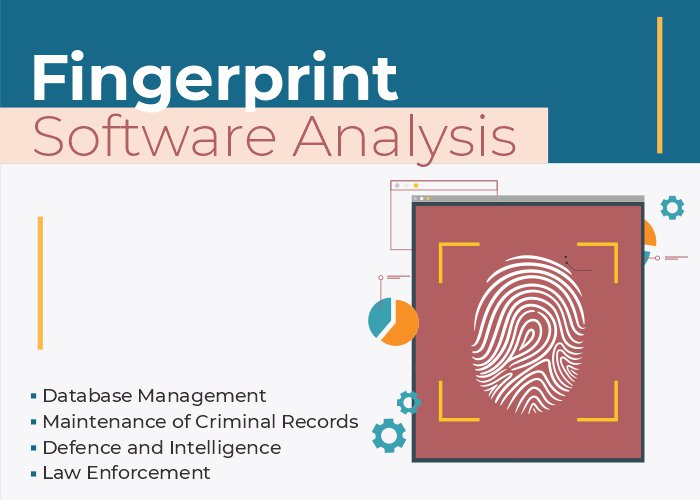
Fingerprint identification requires absolute accuracy in the forensic world. The examination of fingerprint patterns continues to serve as a fundamental method for identifying suspects and authenticating persons. Custom fingerprint software solutions now provide better performance than traditional techniques while achieving enhanced precision. We will analyze how these innovative software programs reshape different professional fields.
What Is Advanced Fingerprint Software?
Advanced fingerprint software runs sophisticated digital tools that look at fingerprints to discover matching patterns better than standard methods. The technology relies on AI, ML and automation to boost the standard fingerprint analysis system.
This advanced software delivers faster and better results by doing repetitive work automatically and reduces mistakes for modern forensic investigations.
Features of Advanced Fingerprint Software
What sets advanced fingerprint software apart is its array of powerful features that streamline the analysis process:
1. High-Speed Processing
Advanced calculations inside the software can review hundreds of fingerprint profiles in just seconds to reduce analysis work time by many hours.
2. Enhanced Accuracy
At its core this tool generates precise identification of fingerprints from all quality levels including poor or missing details.
3. Automated Minutiae Detection
The program finds ridge endings and bifurcations automatically to eliminate human verification needs.
4. Cloud-Based Integration
Tools that use cloud platforms let departments store and access fingerprint data using the same system.
5. Scalability
The software handles extensive fingerprint records and can be expanded to fit fingerprint systems at different levels from individual offices to worldwide networks.
6. Real-Time Matching
Users get quick fingerprint identification answers through the software’s mobile platform in real time.
How Advanced Fingerprint Software Works
The process of fingerprint analysis tools using advanced software typically involves these steps:
Fingerprint Capture
Electronic fingerprint devices scan prints directly from the hand or from marks left on surfaces.
Image Enhancement
The software improves the fingerprint view through clear visibility and stronger detail recognition.
Minutiae Extraction
The system finds and records specialized fingerprint characteristics including ridge patterns and loop structures.
Database Matching
The fingerprint scanner compares digital features to stored prints for any matching results.
Verification and Reporting
The system creates a complete analysis report that forensic experts must verify before it can be used for legal cases.
Applications of Advanced Fingerprint Software
Modern fingerprint systems serve purposes that go well past traditional forensic analysis. Here are some key applications:
1. Criminal Investigations
Law enforcement agencies use detailed fingerprint technology to locate suspected criminals quickly from poor print evidence.
2. Border Security
Public authorities depend on fingerprint technology to maintain border security through accurate identification of travelers.
3. Banking and Finance
Banks deploy fingerprint recognition software to protect their customers through secure digital transactions.
4. Civil Registrations
Aadhaar serves as the Indian national identification system that depends on fingerprint software to keep its biometric database.
5. Disaster Victim Identification
During emergency situations the system identifies people by checking fingerprints in government databases.
6. Corporate Security
Companies use fingerprint software to protect their buildings and track employee movements.
Advantages of Advanced Fingerprint Software
Adopting advanced fingerprint software provides numerous benefits:
Increased Efficiency: Using automated fingerprint services helps organizations complete tasks faster without using as many resources.
Improved Reliability: The software stops workers from making errors and provides dependable findings in every case.
Scalability: The software scales well with large amounts of data in big operations.
Cost-Effectiveness: Using this application helps organizations decrease their future expenses through better process management.
Global Collaboration: Cloud technology helps global law enforcement agencies share their data.
Emerging Trends in Fingerprint Software
Fingerprint software is evolving as technology improves. Some emerging trends include:
AI-Powered Systems: Artificial Intelligence helps enhance how AI systems recognize fingerprints and make better decisions for identification.
Multimodal Biometric Integration: A more secure identification method results when fingerprint records are integrated with facial ID systems, iris pattern detection, and voice pattern checks.
Touchless Fingerprint Scanning: The system extracts fingerprints by contact-free scanning that promotes cleanliness and practical handling.
Blockchain for Data Security: Researchers investigate blockchain technology to protect fingerprint databases against unauthorized users.
Choosing the Right Software
When selecting fingerprint analysis software, it’s essential to consider factors like:
- Accuracy and Reliability
- Ease of Use and Integration
- Compatibility with Existing Systems
- Support for Cloud Storage
- Cost and Licensing
Conclusion
Modern fingerprint analysis tools and services enhance how we work with fingerprints by speeding up and improving their accuracy. These essential tools support our rapidly advancing world by helping investigate crimes and defend border protection.
The next few years will bring advanced fingerprint software capabilities that deliver better precision and reliability as technology keeps improving. By using these advancements we advance forensic science and security much faster than traditional methods.






Leave a Reply